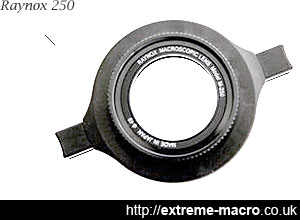Extreme Macro Close up Lenses
by Johan J Ingles-Le Nobel
Last updated August 31, 2017
Extreme macro close up lenses, also known as macro diopter lenses or macro diopters, are an excellent introduction to extreme macro as they allow the full use of aperture control through the camera. They are also reasonably priced and can be sold on if extreme macro proves not to be for you.
Closeup filters will increase the magnification that you can obtain using lenses, especially as you use them on lenses with a focal length upwards of 100mm. See for yourself:

Raynox macro diopter lens, definitely the recommended way to start out in extreme macro because the electronic controls remain available (ie setting f/stop in the body). Unlike low quality close up lenses, achromatic Raynoxes give superb image quality for a very reasonable price, they're about £50 each. You don't absolutely have to use these Raynox snap-on things to attach it to your primary lens either and by using various adapters it is perfectly possible to even stack them. I use a DCR150 and DCR250 stacked on a 50-200mm consumer zoom and it works great.
Image Quality
Of the various types of lenses for extreme macro, the fact of the matter is that closeup lenses do by and large have a poor reputation; there seems to be much more streetcred using reverse lenses or extension tubes.
For bad diopters, the cheap eBay ones, this is warranted - simply put, there is an optical problems bending light rays uniformly for extreme macro magnification by adding an element (or elements) in front of other existing lens elements, which is what diopters do.
On the other hand there is also a certain amount of snobbery against these; your best bet would be to see some images taken with Raynox diopters and see if their quality is right for you.
Raynox closeup lenses deliver excellent quality and are a great road into extreme macro. Start with the 150 then move onto the 250 for added magnification.

A little weevil shot headon with a couple of Raynoxes stacked on top of each other and a cheap consumer zoom. Don't listen to the snobbery against Raynox closeup lenses or macro adapters in general. Achromatic lenses like Raynox closeup lenses are perfectly capable of creating superb extreme macro shots and won't cost you the earth.
Cheap Closeup Lenses
Cheap eBay closeup lenses are things of the devilLike anything, there are of course good macro closeup lenses and not so good macro closeup lenses. Cheap eBay closeup lenses are things of the devil and belong firmly in the latter category. They tend towards severe degradation of the image and don't even cut it as paperweights.
Recommended Closeup Lenses
There are various recommended brands of closeup lenses but they share one primary characteristic: they are achromatic. Single element diopters give colour fringing on the edges that undermine image quality; choose a multi-element Achromat Single element diopters give colour fringing on the edges that undermine image quality; choose an Achromat.
Raynox are currently the Achromat of choice as they are easy to find but other brands have previously made achromatic closeup lenses, and you maybe able to find these on eBay. Now discontinued achromatic diopters from Pentax, Canon, Heliopan, Nikon, Zork, Olympus, Konika, Sony, Sigma, Schneider, Kenco, Leica & Cosina do come up from time to time: make sure the filter thread is compatible with the lens you intend to use them on.
There are also single element lenses from Hoya, Kood, etc which are not listed here and should be avoided for extreme macro.
Achromatic Lenses
An achromatic lens or Achromat is a lens that is designed to limit the effects of chromatic and spherical aberration.
designed to limit the effects of chromatic and spherical aberration
Achromatic lenses are corrected to bring two wavelengths (typically red and blue) into focus in the same plane.
The most common type of Achromat is the achromatic doublet, which is composed of two individual lenses made from glasses with different amounts of dispersion.
Typically, one element is a negative (concave) element made out of flint glass, which has relatively high dispersion, and the other is a positive (convex) element made of crown glass, which has lower dispersion.
The lens elements are mounted next to each other, often cemented together, and shaped so that the chromatic aberration of one is counterbalanced by that of the other.
Raynox Achromatic Closeup Lenses
For Canon folk, the Raynox DCR-150 is a good choice to start with a kit 18-135 IS lens. It is a +4.8 diopter lens, focal length about 210 mm. Used in front of a 18-135 IS lens, it will go up to about 0.65X, so a field width of about 35mm on a 550D.
Should you seek higher magnification, you might go up to the DCR-250 at +8 diopters, which will get you to a little more than 1:1, about 21 mm field width.
A nice, but discontinued diopter set from Raynox, is the Raynox CM-3500 set. The most powerful of the three is identical to the excellent MSN-202 diopter. The +12 lens in that set works well in combination with a 100/105mm macro lens and an APSC sized sensor. However, bear in mind that MSN-202 does not have a front thread so cannot easily be coupled with anything beyond that.
Related Articles


